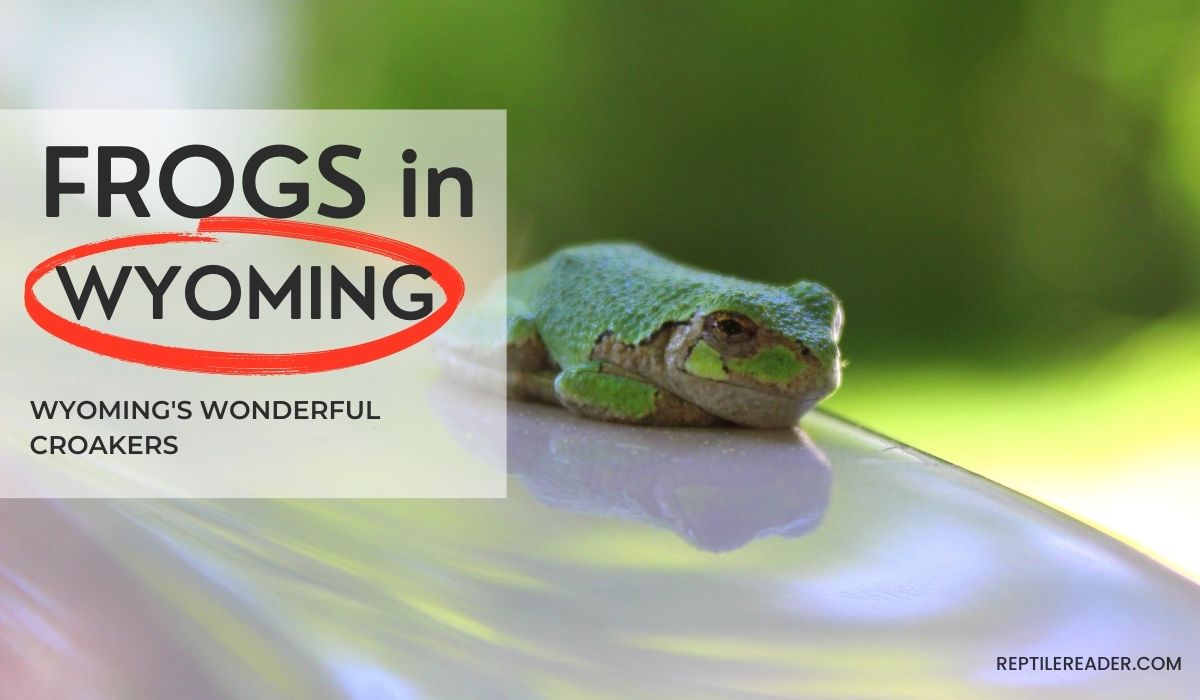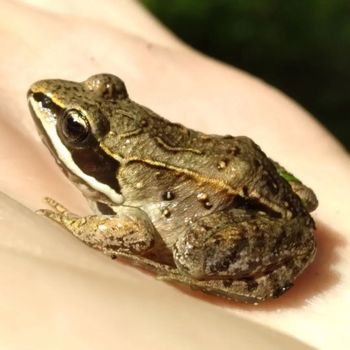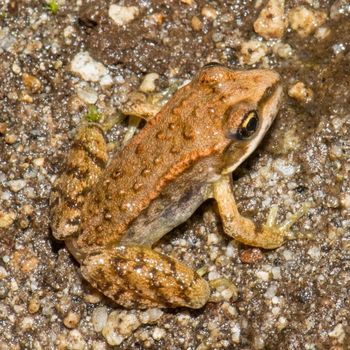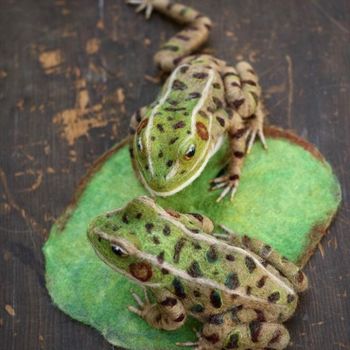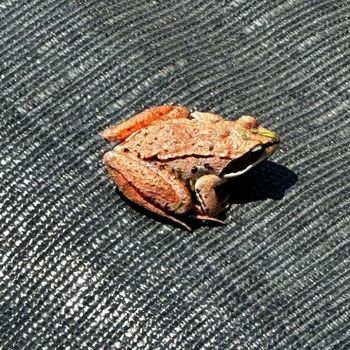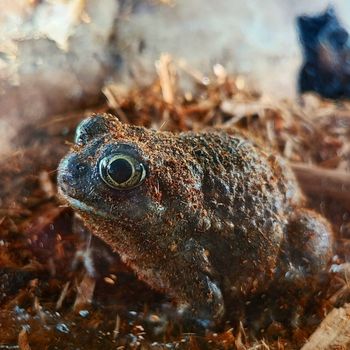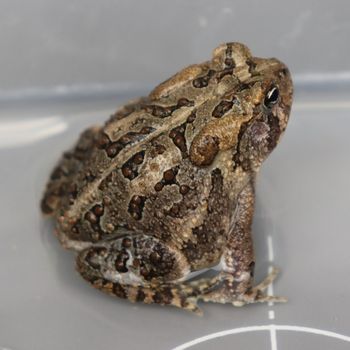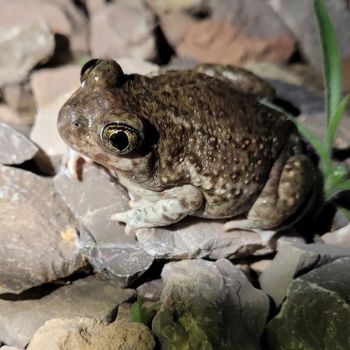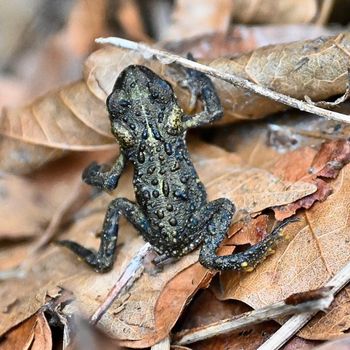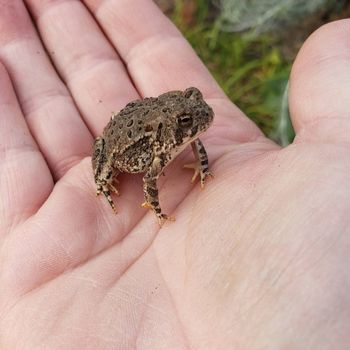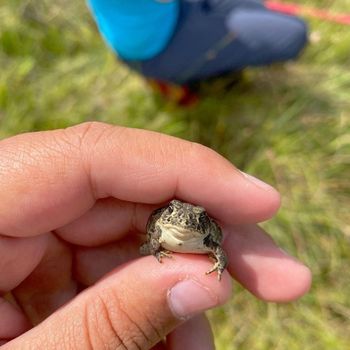Frogs in Wyoming: Wyoming’s Wonderful Croakers
Have you ever wondered just how many different species of our favorite amphibians call Wyoming home? Well, you’re in luck — there are actually 11 distinct species hopping around this beautiful state!
From the high mountains to the vast plains, Wyoming provides various habitats for these fascinating creatures. Whether you’re a wildlife photographer, a student of biology, or simply an admirer, you’re certainly in for a treat!
So, let’s embark on a journey together to discover what makes each of these remarkable species unique and why Wyoming is just the place for them to flourish. The world of amphibians awaits!
| # | Name | Details | Image |
| 1 | American Bullfrog (Lithobates catesbeianus) |
| 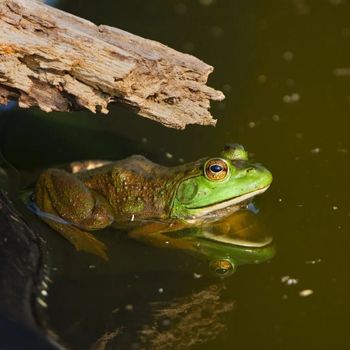 |
| 2 | Boreal Chorus Frog (Pseudacris maculata) |
| 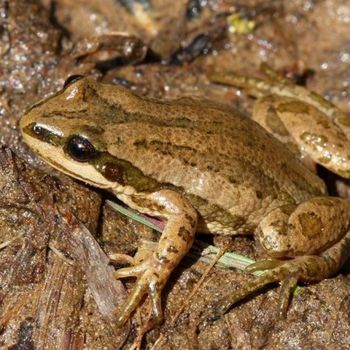 |
| 3 | Columbia Spotted Frog (Rana luteiventris) |
| 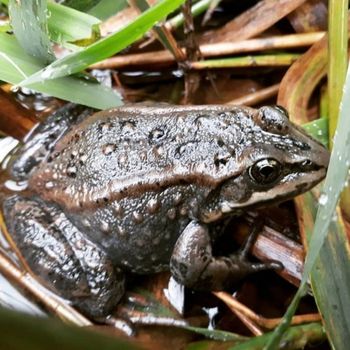 |
| 4 | Northern Leopard Frog (Rana pipiens) |
| 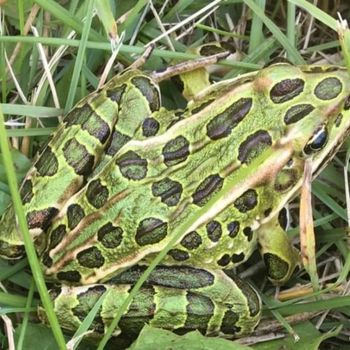 |
| 5 | Wood Frog (Rana sylvatica) |
| 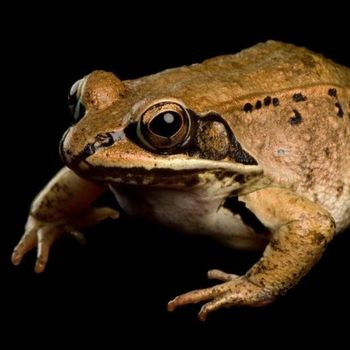 |
| 6 | Great Basin Spadefoot Toad (Spea intermontana) |
| 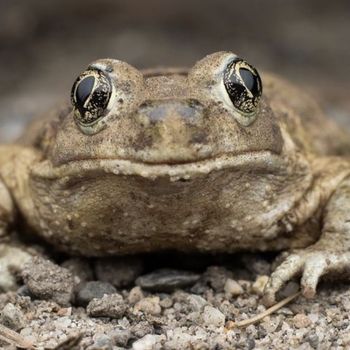 |
| 7 | Great Plains Toad (Anaxyrus cognatus) |
| 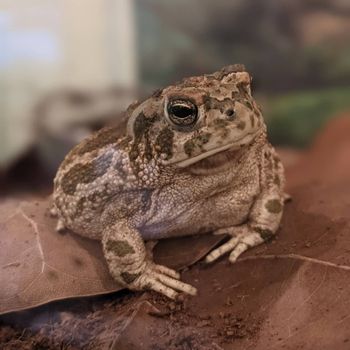 |
| 8 | Plains Spadefoot Toad (Spea bombifrons) |
| 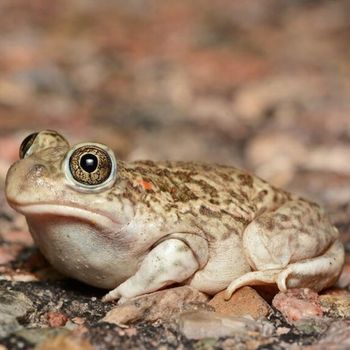 |
| 9 | Western Toad (Bufo boreas) |
|  |
| 10 | Woodhouse’s Toad (Anaxyrus woodhousii) |
|  |
| 11 | Wyoming Toad (Bufo baxteri) |
| 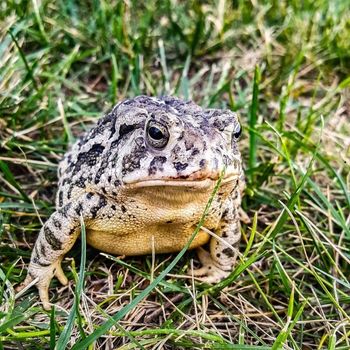 |
11 Frog Species You Can Find in Wyoming
Get ready to dive deep into the lives of 11 incredible frog species that call Wyoming their home, showcasing their unique adaptations and remarkable behaviors.
1. American Bullfrog
- Scientific Name: Lithobates catesbeianus
- Common Name: American bullfrog
- Size: 3.5-6 inches (9-15 cm)
- Color & Pattern: Green to brown with dark spots and patterns
- Natural Habitat: Ponds, lakes, marshes, slow-moving streams
- Geographic Range: Eastern and central united states, canada, mexico, introduced worldwide
- Diet: Fish, crustaceans, insects, small mammals, birds, other amphibians
- Reproduction: Breeds in aquatic habitats, lays eggs in flat surfaces on water
- Vocalization: Deep, low-pitched calls by males during breeding
- Adaptation: Highly adaptable, strong legs for jumping and swimming
- Conservation Status: Least concern
Immerse yourself in the world of the American Bullfrog (Lithobates catesbeianus), a striking amphibian with a size ranging from 3.5 to 6 inches (9-15 cm). Adorned in a rich palette of green to brown, they exhibit dark spots and patterns which serve as excellent camouflage within their habitat. These aquatic creatures can leap and swim with grace and strength, due to their powerful legs.
Dwelling in the eastern and central United States, Canada, Mexico, and various regions around the world, they call ponds, lakes, marshes, and slow-moving streams their home. They satiate their hunger with a diverse diet of fish, crustaceans, insects, small mammals, birds, and other amphibians. The American Bullfrog is even known to be cannibalistic, predating on native species in introduced areas.
During breeding season, male Bullfrogs exclaim deep, low-pitched calls to attract mates, resulting in them laying their eggs in flat surfaces on the water for successful reproduction. Despite being a significant predator, their conservation status remains of least concern and they continue to thrive, showcasing their impressive adaptability. Delve deeper into the world of this fascinating amphibian, and uncover more about its unique quirks and captivating existence.
2. Boreal Chorus Frog
- Scientific Name: Pseudacris maculata
- Common Name: Boreal chorus frog
- Size: 0.8-1.6 inches (2-4 cm)
- Color & Pattern: Gray, brown or green with dark stripes on the back and sides
- Natural Habitat: Marshes, grasslands, wet meadows
- Geographic Range: Northwestern united states and canada
- Diet: Small insects, spiders, and other invertebrates
- Reproduction: Breeds in shallow water, lays eggs attached to vegetation
- Vocalization: Series of ascending, short trills
- Adaptation: Able to change color for camouflage, strong climbers
- Conservation Status: Least concern
Hidden in the marshes, grasslands, and wet meadows of northwestern United States and Canada, the small creature with a big voice, the Boreal Chorus Frog, thrives. Although diminutive in size, measuring only 0.8-1.6 inches, their distinct colors and patterns of gray, brown, or green with dark stripes on the back and sides allow them to stand out in their environment. Pseudacris maculata, as they’re known in the scientific community, have an impressive ability to change their color for camouflage and are remarkable climbers.
Surviving primarily on small insects, spiders, and other invertebrates, these talented amphibians lay their eggs attached to vegetation in shallow water, filling the surrounding area with a series of ascending, short trills to establish their presence. Fascinatingly, these frogs have developed concentrated antifreeze proteins that allow them to endure freezing temperatures – a vital adaptation in their often chilly habitat.
Fortunately, the conservation status of this Wyoming resident is deemed the least concern due to their versatile adaptations and stable population, ensuring these interesting creatures remain an essential part of their ecosystem.
3. Columbia Spotted Frog
- Scientific Name: Rana luteiventris
- Common Name: Columbia spotted frog
- Size: 1.5-4 inches (3.8-10 cm)
- Color & Pattern: Black, brown or green with irregularly shaped spots
- Natural Habitat: Wetlands, streams, lakes, ponds
- Geographic Range: Western north america (alaska to nevada)
- Diet: Aquatic insects, spiders, small invertebrates
- Reproduction: Breeds in quiet ponds, lays eggs in clusters attached to vegetation
- Vocalization: Low-pitched, rapid chuckling or clicking call by males during breeding
- Adaptation: Explosive jump for escape, webbing on hind feet for swimming
- Conservation Status: Least concern
From Alaska to Nevada, you’ll find these small amphibians – ranging from 1.5 to 4 inches in size – leisurely residing in wetlands, streams, lakes, and ponds. Their diet primarily consists of aquatic insects, spiders, and other small invertebrates hiding in their watery abodes.
Males of this elusive species serenade their female counterparts with low-pitched, rapid chuckling or clicking calls during breeding. You’ll find their eggs in clusters attached to vegetation within the serene waters of quiet ponds. Keep an eye out for their astonishing explosive jumps for escape, and watch them gracefully swim using the webbing on their hind feet – natural adaptations serving their survival in aquatic habitats.
Did you notice a flash of red or orange on the frog’s belly? That’s a distinctive feature of the Columbia Spotted Frog. Not only visually striking, but these little frogs are also essential to our understanding of wetlands, as they serve as a habitat indicator species. Although their conservation status is currently “least concern,” let’s celebrate and protect these incredible, vibrant creatures and the vital habitats they call home.
4. Northern Leopard Frog
- Scientific Name: Rana pipiens
- Common Name: Northern leopard frog
- Size: 2.0-4.3 inches (5.1-11 cm)
- Color & Pattern: Green or brown with dark spots circled by a lighter border
- Natural Habitat: Marshes, swamps, grasslands, wetlands
- Geographic Range: Canada and the united states (alaska to new mexico)
- Diet: Insects, spiders, small crustaceans, other invertebrates
- Reproduction: Breeds in shallow, well-vegetated freshwater habitats, lay eggs in clusters attached to vegetation
- Vocalization: Snore-like call by males during breeding
- Adaptation: Long, powerful legs for jumping, partially webbed hind feet for swimming
- Conservation Status: Least concern
These captivating creatures are perfectly suited for life in marshes, swamps, grasslands, and wetlands, stretching from Alaska to New Mexico in North America. Their partially webbed hind feet allow them to swim gracefully, while their long, powerful legs support impressive jumping abilities.
With a main diet of insects, spiders, small crustaceans, and other invertebrates, these voracious eaters keep their habitats in Wyoming lively. During breeding season, these frogs settle in shallow, well-vegetated freshwater habitats, and females lay eggs in clusters attached to vegetation. To attract a mate, male frogs serenade their companions with a unique, snore-like vocalization.
Remarkably, the Northern Leopard Frog is capable of surviving being frozen, an unparalleled adaptation contributing to their classification as “Least Concern” in conservation statuses. However, it is worth noting that habitat loss may lead to a decline in future populations. Overall, these fascinating frogs continue to enchant us with their beauty, resilient nature, and captivating behaviors.
5. Wood Frog
- Scientific Name: Rana sylvatica
- Common Name: Wood frog
- Size: 1.4-3.7 inches (3.5-7.6 cm)
- Color & Pattern: Tan or brown with dark mask around eyes and back leg stripe
- Natural Habitat: Woodlands, bogs, swamps
- Geographic Range: North america, from alaska to new england, and south to northern georgia
- Diet: Insects, spiders, worms, slugs, snails
- Reproduction: Breeds in freshwater habitats, lays eggs in clusters attached to vegetation
- Vocalization: Males make a duck-like quacking sound during breeding
- Adaptation: Ability to freeze and thaw as a means to survive cold conditions
- Conservation Status: Least concern
Meet the captivating Rana sylvatica, commonly known as the Wood Frog, a forest-dwelling amphibian with an exquisite flair for blending into its surroundings. Sporting a fashionable tan or brown, adorned with a dark mask around its eyes, and a sleek stripe on its back legs, this petite creature ranges from 1.4-3.7 inches in size (3.5-7.6 cm). Its range spans North America, from the bustling wilds of Alaska to New England, with southern settlers in northern Georgia.
A gourmand of small delicacies, the Wood Frog feasts on a varied menu consisting of insects, spiders, worms, slugs, and snails. Its breeding rituals take place in the serene freshwater habitats it calls home, laying its precious eggs in clusters that find attachment on submerged vegetation. The debonair males serenade potential mates with duck-like quacking during these amorous encounters.
The true pièce de résistance of this incredible species is their unparalleled ability to freeze and thaw, permitting survival in harsh, cold conditions. Amidst this extraordinary talent, the Wood Frog is not considered at risk with a conservation status deemed of least concern. The fascinating life of the Wood Frog unfolds with eggs hatching within mere weeks, showcasing their resilient nature and true wonder.
6. Great Basin Spadefoot Toad
- Scientific Name: Spea intermontana
- Common Name: Great basin spadefoot toad
- Size: 1.5-3 inches (3.8-7.6 cm)
- Color & Pattern: Green to brown with dark spots, light-colored stripe along spine
- Natural Habitat: Sagebrush, grasslands, desert scrub
- Geographic Range: Southwestern canada, western us
- Diet: Insects, spiders, small invertebrates
- Reproduction: Breeds in temporary pools, lays eggs attached to vegetation
- Vocalization: Males make low-pitched chirping noises during breeding
- Adaptation: Spade-like appendages on hind feet for digging, can secrete toxin from skin
- Conservation Status: Least concern
Donning hues of green to brown, decorated with mysterious dark spots and an elegant light-colored stripe down its spine, this small creature measures just between 1.5-3 inches. Roaming the sagebrush, grasslands, and desert scrub landscapes of Wyoming, this petite amphibian can be found spreading its charm throughout the southwestern expanses of Canada and the western US.
Always on the hunt for delicious insects, spiders, and small invertebrates, the Great Basin Spadefoot Toad knows how to survive. But once it’s time for reproduction, this little wonder seeks out temporary pools to lay its eggs, carefully attaching them to nearby vegetation. During the breeding season, males serenade their partners with low-pitched, harmonious chirping noises.
Possessing impressive adaptations, the Spea intermontana is well-equipped for its environment. Its hind feet showcase spade-like appendages for digging, and they can even secrete toxins to discourage predators. This extraordinary toad goes into aestivation during dry periods, shedding its skin in a unique “cocoon” during emergence. With a conservation status of “least concern”, it seems, for now, the enchanting Great Basin Spadefoot Toad is here to stay.
7. Great Plains Toad
- Scientific Name: Anaxyrus cognatus
- Common Name: Great plains toad
- Size: 3-4.5 inches (7.5-11.4 cm)
- Color & Pattern: Green or brown with dark blotches; a white stripe down the center of the back
- Natural Habitat: Grasslands, sagebrush, floodplains
- Geographic Range: Central north america (southern canada to mexico)
- Diet: Insects, spiders, small invertebrates
- Reproduction: Breeds in temporary pools, lays eggs in long strings
- Vocalization: Multi-trill call by males during breeding
- Adaptation: Thick skin to minimize water loss, explosive breeding during rains
- Conservation Status: Least concern
The fascinating Anaxyrus cognatus, commonly known as the Great Plains Toad, boasts a captivating appearance with its distinct green or brown hues and dark blotches adorning its 3-4.5-inch body. This charming creature also features a striking white stripe running down the center of its back, making it a truly captivating sight in the wild.
Roaming across the vast grasslands, sagebrush, and floodplains of Central North America, these captivating amphibians have an insatiable appetite for insects, spiders, and small invertebrates. The alluring melodies of their multi-trill calls echo through the air, as males serenade their potential mates during breeding season in temporary pools where they lay their eggs in long strings.
Notable for their thick skin, designed to minimize water loss, the Great Plains Toad adapts to its environment by employing explosive breeding during rains and burrowing in the soil to aestivate during dry periods. With a current conservation status of “Least Concern,” we can continue to marvel at these extraordinary toads and their remarkable abilities.
8. Plains Spadefoot Toad
- Scientific Name: Spea bombifrons
- Common Name: Plains spadefoot toad
- Size: 1-2.5 inches (2.5-6.3 cm)
- Color & Pattern: Greenish, grayish, or brown with darker spots or blotches
- Natural Habitat: Grasslands, savannas, prairies
- Geographic Range: Great basin, great plains regions of the united states and canada
- Diet: Insects, spiders, small invertebrates
- Reproduction: Breeds in temporary pools, lays eggs singly or in small clusters
- Vocalization: Males create low-pitched, snore-like calls during breeding
- Adaptation: Hard, spade-like projections on hind legs for digging, secretion of toxin, estivation in dry periods
- Conservation Status: Least concern
Venture into the Great Basin and Great Plains regions of the United States and Canada, and you may stumble upon the enchanting Plains Spadefoot Toad (Spea bombifrons). This mysterious creature exhibits a captivating color scheme of greenish, grayish, or brown with darker spots or blotches, blending seamlessly into grasslands, savannas, and prairies, its preferred habitat.
Measuring 1-2.5 inches (2.5-6.3 cm) and feasting on insects, spiders, and other small invertebrates, this toad can be quite elusive. Yet, during breeding season, males can be heard creating low-pitched, snore-like calls, luring a mate to temporary pools where they lay their eggs singly or in small clusters. Interestingly, other toads have been known to mimic the call of the Plains Spadefoot Toad.
Equipped with hard, spade-like projections on its hind legs, the Plains Spadefoot Toad can burrow into the earth during dry periods, a process known as estivation. This resourceful creature residing in Wyoming also secretes toxins as a defense mechanism. Though its conservation status is currently of “least concern,” heavy rains can draw these fascinating toads to the surface, revealing their presence to the curious observer.
9. Western Toad
- Scientific Name: Bufo boreas
- Common Name: Western toad
- Size: 3-5 inches (7.6-12.7 cm)
- Color & Pattern: Brown, gray, green, or olive with dark blotches; light dorsal stripe
- Natural Habitat: Forests, meadows, wetlands, and grasslands
- Geographic Range: Western north america (from alaska to mexico)
- Diet: Insects, spiders, worms, small invertebrates
- Reproduction: Breeds in freshwater habitats, lays eggs in long strings
- Vocalization: Low-pitched short trills by males during breeding
- Adaptation: Glands secrete toxin, can breed in ephemeral ponds
- Conservation Status: Near threatened
This small yet fascinating creature ranges from 3 to 5 inches in size, boasting a captivating palette of brown, gray, green, or olive hues, adorned with dark blotches and a striking light dorsal stripe. Their nocturnal nature adds a certain air of mystery, as they dig burrows and hibernate during the biting winter months.
Making their homes in forests, meadows, wetlands, and grasslands, these toads have claimed an extensive territory spanning western North America—from the frosty expanse of Alaska to the sun-soaked stretches of Mexico. Known for their carnivorous appetite, Western Toads feast on insects, spiders, worms, and other small invertebrates, ensuring a balanced ecosystem in their diverse habitats. The low-pitched short trills of males during breeding season prove they are nothing if not romantic.
These fascinating creatures have uniquely adapted to their environment; glands in their skin secrete a powerful toxin to ward off predators, and their ability to breed in ephemeral ponds showcases their resilience. However, Western Toads are currently considered near threatened, emphasizing the need for diligent conservation efforts. Their captivating story serves as a stark reminder for us to appreciate the beauty and complexity of the wild.
10. Woodhouse’s Toad
- Scientific Name: Anaxyrus woodhousii
- Common Name: Woodhouse’s toad
- Size: 2-5 inches (5-12.7 cm)
- Color & Pattern: Gray, green, or brown with dark blotches, light-colored midline stripe
- Natural Habitat: Grasslands, shrublands, forests, agricultural fields
- Geographic Range: Western north america (from southern canada to northern mexico)
- Diet: Insects, spiders, and other small invertebrates
- Reproduction: Breeds in temporary or permanent bodies of water, lays eggs in long strings
- Vocalization: Males produce a long, nasal trill during breeding season
- Adaptation: Parotoid glands secrete bufotoxin, good burrowers
- Conservation Status: Least concern
Anaxyrus woodhousii, commonly known as Woodhouse’s Toad, is a small and adaptable amphibian found throughout western North America – from the fields of southern Canada to the forests of northern Mexico. Measuring 2-5 inches in length, this friendly toad boasts a mottled gray, green, or brown appearance with dark blotches and a distinctive light-colored midline stripe down its back.
This resourceful creature thrives in a range of habitats, from grasslands and shrublands to forests and agricultural fields. They enjoy a hearty diet of insects, spiders, and other small invertebrates. During the breeding season, male Woodhouse’s toads serenade their potential mates with a long, nasal trill, laying their eggs in lengthy strings within temporary or permanent bodies of water.
The Woodhouse’s Toad is well adapted for survival, possessing parotoid glands that secrete a potent toxin called bufotoxin to deter predators. They are also adept burrowers, easily creating underground shelters. Although their conservation status is currently listed as “least concern,” their populations have been impacted by pesticide use. This versatile and resilient toad continues to play an essential role in our diverse North American ecosystems.
11. Wyoming Toad
- Scientific Name: Bufo baxteri
- Common Name: Wyoming toad
- Size: 2.2-2.6 inches (5.6-6.6 cm)
- Color & Pattern: Brown or grayish-brown with small, dark blotches
- Natural Habitat: Wet meadows, floodplains, and ponds
- Geographic Range: Restricted to laramie basin, wyoming
- Diet: Ants, beetles, spiders, and other small invertebrates
- Reproduction: Lays eggs in water, clumps of eggs attach to aquatic vegetation
- Vocalization: Males emit a high-pitched, short call during mating season
- Adaptation: Secretes toxins from dorsal glands, burrows to escape heat and moisture loss
- Conservation Status: Critically endangered
Adorned with a charmingly subtle brown or grayish-brown palette, this little creature proudly sports small, dark blotches as its signature pattern. The toad is skilled in the art of camouflage, seamlessly blending into its preferred habitats of wet meadows, floodplains, and ponds in the Laramie Basin, Wyoming.
A gourmand with a penchant for ants, beetles, spiders, and other small invertebrates, the Wyoming Toad is never one to shy away from a delectable meal. As for romance, this tiny Romeo showcases his vocal prowess during mating season, emitting a high-pitched, short call to impress potential mates. Once the deed is done, Bufo baxteri lays her precious cargo in clumps of eggs, attaching them lovingly to aquatic vegetation.
Sadly, this fascinating creature has found itself listed as Critically Endangered, with a fighting chance at survival through captive breeding and reintroduction programs. The Wyoming Toad’s unique adaptations, such as secreting toxins from its dorsal glands and burrowing to escape heat and moisture loss, are vital aspects of its incredible story and serve as a reminder for us to cherish and protect these vulnerable species.
Nearby States:
Do Wyoming and Oklahoma have similar frog species?
Wyoming and Oklahoma both have diverse frog populations, but the types of frogs in oklahoma’s amphibians may differ from those found in Wyoming. While both states are home to various frog species, the specific types and ecological niches of frogs in Oklahoma’s amphibians may vary from those in Wyoming.
What Makes Wyoming’s Frog Population Unique Compared to Virginia’s?
Wyoming’s frog population stands out for its adaptation to the state’s varied climate and landscape. In contrast, those who want to learn about virginia’s frogs will discover a different range of species due to the state’s more diverse ecosystems. This makes Wyoming’s frog population unique compared to Virginia’s.
How Do Frogs in Oregon Compare to Wyoming’s Wonderful Croakers in Terms of Species and Habitat?
Frogs in oregon wildlife thrive in diverse, moist habitats, including wetlands and forests, while Wyoming’s croakers are often found in high-altitude lakes and arid environments. Oregon’s frog species like the Northern Red-legged Frog contrast with Wyoming’s Boreal Chorus Frogs, highlighting the impact of geography on amphibian diversity and adaptation.
¿Cuáles son las diferencias en las especies de ranas entre Wyoming y Florida?
Wyoming y Florida albergan una fascinante variedad de ranas, cada una con sus propias características distintivas. Mientras que en Wyoming predominan las ranas de montaña, en Florida es común encontrar especies adaptadas a ambientes cálidos y húmedos, como la rana toro y la rana de árbol verde. Estas diferencias son el resultado de adaptaciones al entorno local.
Final Words
In summary, Wyoming boasts a remarkable array of 11 diverse frog species, displaying a kaleidoscope of colors, patterns, and unique adaptations. Embark on a fascinating journey through their habitats, appreciating their distinctive vocalizations, and uncover the secret lives of these magnificent amphibians that grace the state of Wyoming. From the alpine meadows to the sprawling wetlands, each species plays a critical role in maintaining the delicate ecological balance of the region. Interestingly, some of these Wyoming species share similarities with the frogs found in Missouri, though their behaviors and environmental adaptations may differ significantly due to the contrasting climates. Regardless of the location, these frogs hold invaluable insight into the health of their ecosystems and continue captivating both researchers and nature enthusiasts alike.

